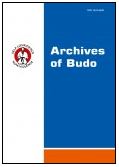2012, Volume 8, Issue 2
Interrelation between predisposition to work under different energy modes and individual characteristics of skilled wrestlers’ tactical approachh
Stanislaw Sawczyn1, Władysław Jagiełło1, Valentin I. Fetisov2, Viktor S. Mishchenko1
1University of Physical Education and Sports, Gdansk, Gdańsk, Poland
2European University, Kiev, Kiev, Ukraine
Author for correspondence: Władysław Jagiełło; University of Physical Education and Sports, Gdansk, Gdańsk, Poland; email: wjagiello1[at]wp.pl
Full text
Abstract
Background and Study Aim: It is known that athletes have different development levels of individual aspects of energy capacity. This is determined to a great extent by the unique, innate physiology of the individual. Therefore, these differences may influence a wrestler’s individual inclinations to a specific manner of technico-tactical action during competition. The objective of this study was to reveal the relation between individual predisposition to work under different energy modes as indicated by particular aspects of specialized physical fitness and the tactical approach of free-style wrestlers.
Material and Methods: The participants of the study included 31 free-style wrestlers, aged 19-26, and weighting 63-89 kg, of a national or international level, with 5-13 years of competitive wrestling experience. Wrestlers performed three types of ergometric tests: anaerobic alactate (10 s), anaerobic lactate (30 s) and aerobic power estimation (VO2 max). Tactical approach, indices of wrestling tests and some indices of special physical fitness were determined.
Results: A significant range of individual capacities of anaerobic alactate, lactate and aerobic systems of work energy supply were demonstrated in a homogeneous group of skilled wrestlers. Three groups of wrestlers were singled out according to criterion of expressed power development of one of the aforementioned work energy supply aspects. Relative independence of various aspects of energy capacity development level indices was noted among the groups. They were related to the specific activity of wrestlers during matches (characteristics of attack and volume of technical actions), tactical approach (technical, functional and speed-strength) and characteristics of specific physical fitness tests.
Conclusion: Thus, a relationship exists between the prevalence of one or another aspect of energy capacity in a wrestler, as indicated by certain characteristics of specific fitness and the wrestler’s tactical approach.
Key words: free-style wrestling, specialized physical fitness, specific matches activity, work energy supply




